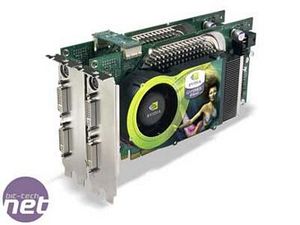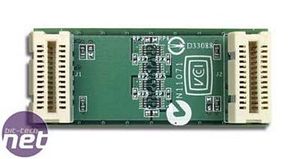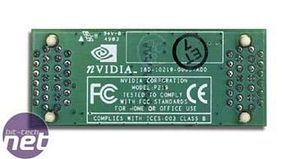
So, PCI-Express is here, and so is SLI. The question is: how do you connect two graphics cards together to work in tandem? In order to make use of this technology, you\'ll need two identical NV45 graphics boards (requiring two PCI-E 16x slots on your motherboard), the SLI bridge connector.
Data transfer between the two cards remains a purely digital signal, avoiding the signal degradation found on Voodoo2 SLI that was caused by passing through several Digital / Analogue Converters (DACs) when assembling the final picture - this often resulted in a slightly blurry Windows Desktop.
 There is a small bridge-type PCB that connects the two NV45\'s together in the above image: this is NVIDIA\'s SLI connector. The card connected to the monitor (which I would imagine is the northerly-most card in this configuration) will become the master, while the second card acts as the slave.
There is a small bridge-type PCB that connects the two NV45\'s together in the above image: this is NVIDIA\'s SLI connector. The card connected to the monitor (which I would imagine is the northerly-most card in this configuration) will become the master, while the second card acts as the slave.
Unlike the cable used on Voodoo 2 SLI, which allows some degree of flexibility as to which PCI slots you wanted to use, the PCB is of fixed length, dictating the distance between slots. This is designed to allow for two dual-slot Ultra cards as pictured, and there will simply be more room to breathe when using two single-slot GT cards.

 There are no indications as to whether the interface uses a serial or parallel data throughput - on this note, data sent at high speed using a parallel interfaces are typically more sensitive to signal routing. NVIDIA have indicated that there is no requirement for a pass-through cable, and that there is no plan to implement a cabled solution at present - the PCB implementation is providing better signalling levels. Having said that, NVIDIA are actively looking for different solutions, which in turn, may provide superior signalling compared to the PCB connector.
There are no indications as to whether the interface uses a serial or parallel data throughput - on this note, data sent at high speed using a parallel interfaces are typically more sensitive to signal routing. NVIDIA have indicated that there is no requirement for a pass-through cable, and that there is no plan to implement a cabled solution at present - the PCB implementation is providing better signalling levels. Having said that, NVIDIA are actively looking for different solutions, which in turn, may provide superior signalling compared to the PCB connector.
Raw power is usually a good thing, but one consideration that many people should take into account is the noise levels and also the heat generated inside your system. While the 6800 Ultra features a driver-level \"Smartfan\" function that adjusts fanspeed according to temperature level, running TWO cards in close proximity could result in unwanted noise levels. You should obviously make sure that general case ventilation is up to scratch too, as these babies pump out around 120W each!
 As discussed earlier, here is a board with two PCI-E slots - it is in fact a Dual Xeon board. You can clearly see how the regular PCI slot is sandwiched by the PCI-E slots and therefore creates the required amount of breathing room.
As discussed earlier, here is a board with two PCI-E slots - it is in fact a Dual Xeon board. You can clearly see how the regular PCI slot is sandwiched by the PCI-E slots and therefore creates the required amount of breathing room.
Data transfer between the two cards remains a purely digital signal, avoiding the signal degradation found on Voodoo2 SLI that was caused by passing through several Digital / Analogue Converters (DACs) when assembling the final picture - this often resulted in a slightly blurry Windows Desktop.

Unlike the cable used on Voodoo 2 SLI, which allows some degree of flexibility as to which PCI slots you wanted to use, the PCB is of fixed length, dictating the distance between slots. This is designed to allow for two dual-slot Ultra cards as pictured, and there will simply be more room to breathe when using two single-slot GT cards.


Raw power is usually a good thing, but one consideration that many people should take into account is the noise levels and also the heat generated inside your system. While the 6800 Ultra features a driver-level \"Smartfan\" function that adjusts fanspeed according to temperature level, running TWO cards in close proximity could result in unwanted noise levels. You should obviously make sure that general case ventilation is up to scratch too, as these babies pump out around 120W each!


MSI MPG Velox 100R Chassis Review
October 14 2021 | 15:04






Want to comment? Please log in.